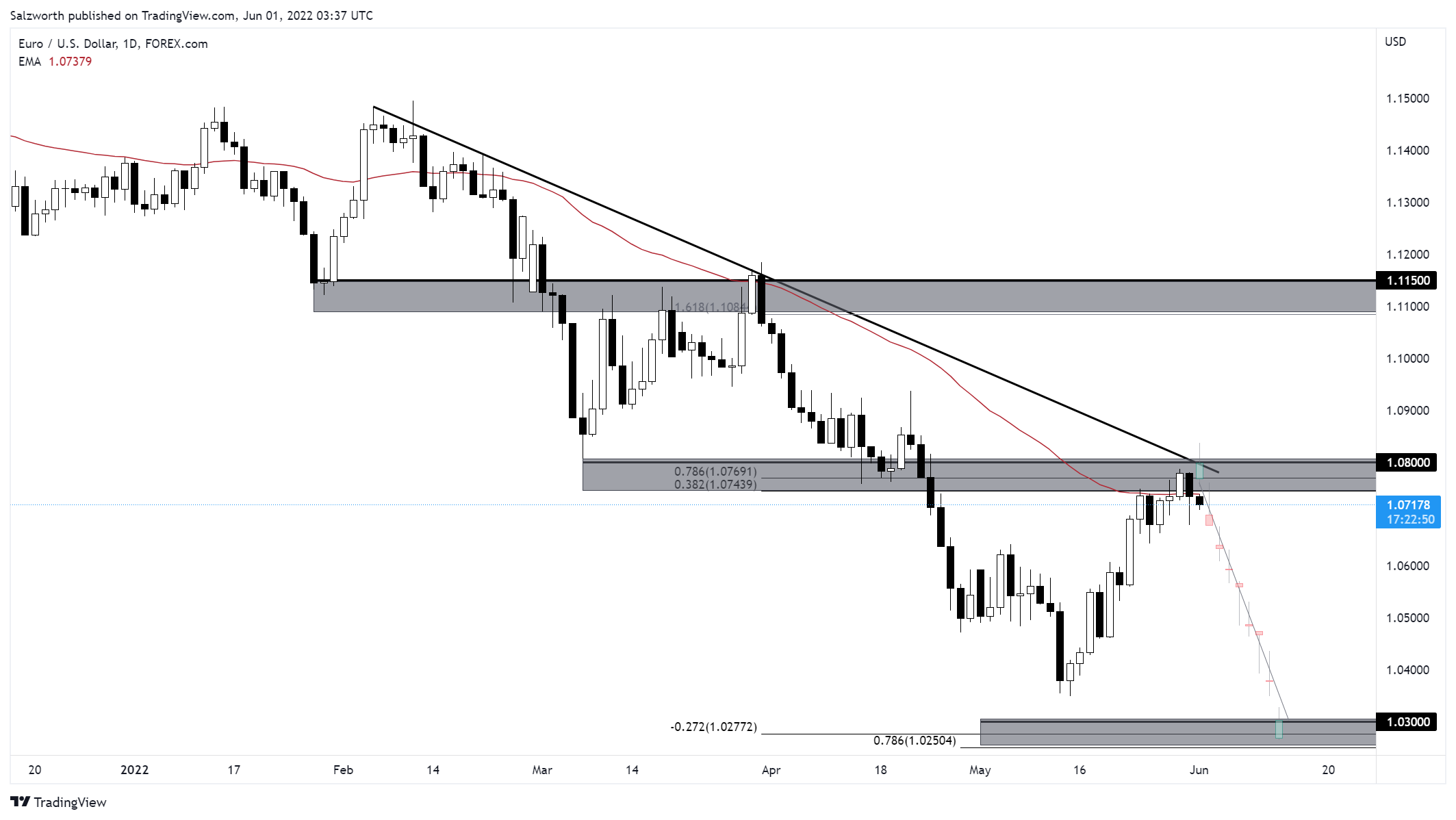
2022 June Outlook for G7 Currencies
2022 June Outlook for G7 Currencies
Dollar, Euro and Pound
Dollar rally pauses for breadth: Dollar retreated from its 20-year high following expectations that the Fed could pause its tightening cycle after hikes of 50 basis points in June and July. The latest FOMC minutes released hinted that the Fed would not pursue further aggressive rate hikes and provided some relief on the Fed’s forward guidance. While most policy makers believed that rate hikes of 50 basis points would be reasonable to contain inflation in light of the strong economy and tight labour market, the extent of tighter monetary policy for the rest of the year remains uncertain with the Ukraine conflict. On the data front, the core PCE index which is Fed’s preferred gauge of inflation fell to 4.9% yoy in April from 5.2% in March, an indication that price pressures could be easing. On the other hand, robust April’s consumer spending data showed that economy held up well in face of rising prices. Looking ahead, with the May’s Nonfarm payroll around the corner, solid jobs data in the US should provide a boost for the Dollar, alongside prospects of higher interest rates and safe-haven flow amid the risk aversion.
ECB’s shift towards a more hawkish stance: Euro halted four consecutive months of decline against the greenback. The currency had borne the brunt of the hostilities in Ukraine which worsened the energy crisis, soaring inflation and slow growth in the region. The recent shift towards a more hawkish stance from the ECB, with ECB President Christine Lagarde stating that the central bank will likely exit negative interest rates by the end of the third quarter provided some support for the Euro as the monetary policy divergence with the Fed narrowed. Investors expect the ECB to raise rates by 25 basis points in both July and September, with another hike at the end of the year. On the data front, growth outlook in the Eurozone remained resilient against recession, supported by strength in the service sector while cost pressures stayed elevated. Eurozone’s annual inflation soared to a new high of 8.1%, up from 7.4% and ahead of market expectations of 7.7%, putting pressure on the ECB to push forward its rate hikes to rein in inflation. However, downside risks persist for the Euro especially with EU’s recent move to ban Russian oil imports by sea which could further weigh on the Eurozone’s growth and aggravate soaring prices.
BoE battles rising inflation with little room to manoeuvre : In the UK, Chancellor Rishi Sunak announced a Cost of Living Support package to boost consumer spending and alleviate mounting price pressures and living costs. Rising prices for electricity, gas, and other fuels pushed annual inflation in the UK to 9% in April, the highest level since 1982. However, chances of another BoE hike are dwindling due to growth uncertainties. On the data front, the British economy increased at a slower-than-expected 0.8 percent in Q1 and contracted 0.1 percent in March alone, while the Bank of England forecasts the economy to stagnate in Q2 and shrink in Q4. As compared to the Fed, BoE is also seen to have less room to tighten, given that BoE has already hiked borrowing prices four times.
EURUSD: Bearish below 1.0800
| S1 | S2 | R1 | R2 |
| 1.0300 | – | 1.0800 | 1.1150 |

GBPUSD: Bearish below 1.2650
| S1 | S2 | R1 | R2 |
| 1.2180 | – | 1.2650 | 1.3000 |

Commodity Currencies
Aussie boosted by strong domestic growth but remained vulnerable to global risk dynamics: April retail sales data from Australia showed that consumers held up well in the face of rising inflation, recording the fourth consecutive month of growth in retail sales, paving the way for more interest rate hikes. Markets expect the RBA to hike rates in June, citing the economy’s resilience to high inflation and global headwinds. Reports that Shanghai will allow more firms in zero-Covid regions to resume normal operations from the beginning of June also buoyed demand for the risk-sensitive currency, as the country is poised to benefit from a resurgence in consumer demand, especially with China being one of Australia’s largest trading partners. On the politics front, the result of the election with Labour Party leader Anthony Albanese set to become Australia’s 31st prime minister did little to impact the currency’s movement. Under his leadership, we could see further fiscal support as compared to his predecessors, but they are not likely to bring about huge implications in the financial markets. Rather, the currency remains vulnerable to market risk sentiment and developments in China as it emerges from its lockdown.
RBNZ reaffirmed its hawkish stance: In New Zealand, RBNZ raised the Official Cash Rate by 50 basis points to 2%, in line with market expectations, but said that a larger and earlier hike reduces the risk of inflation becoming persistent and projected the cash rate to peak at 3.95% in the third quarter of 2023, ahead of its February forecast for a peak of 3.35% in 2024. The central bank also stated that current pace of tightening remains appropriate and is determined to bring consumer price inflation returns to within the 1-3% target, implying that we could be seeing another 50 basis points hike in its July meeting. Looking ahead, Kiwi remains supported by strong domestic growth and a healthy labour market, alongside easing Covid-19 restrictions as New Zealand is planning to fully reopen its borders after more than two years of Covid-19 restrictions.
Canada continues interest rate hikes: The Bank of Canada raised its interest rate by 50 basis points to 1.5% on the 1st June meeting, in line with market forecasts. Policymakers also committed to further quantitative tightening ahead, signalling possible interest rate hikes in following months of July and September, which has been beneficial to the Canadian dollar in offsetting USD appreciation. Governor of the Bank of Canada, Tiff Macklem, previously stated that the central bank is “committed” to raising interest rates to reduce inflation, and even “forcefully if needed”, enforcing its hawkish stance. Annual inflation in Canada surged to 6.8% in April, well beyond the BOC’s target of 2%, and is expected to rise further before its descent.
Bullish outlook for oil prices: The unwinding of China’s lockdown and the announcement of EU’s embargo on Russian oil caused oil prices to soar to a high of around $118 per barrel in May. Due to increased demand as China exits its lockdown, crude oil prices are projected to rise further in June. The EU’s embargo on cheap Russian crude oil means that the EU will avoid importing at least two-thirds of the country’s oil, causing global supply concerns. OPEC+ is anticipated to stick to their previous oil production agreement and increase output by 432,000 barrels per day in July. The long-term outlook for oil prices should remain supported by supply-side difficulties.
AUDUSD: : Bearish below 0.7350
| S1 | S2 | R1 | R2 |
| 0.7020 | – | 0.7350 | 0.7650 |

NZDUSD: Bearish below 0.6550
| S1 | S2 | R1 | R2 |
| 0.6150 | – | 0.6550 | 0.6750 |

USDCAD: Bullish above 1.2620
| S1 | S2 | R1 | R2 |
| 1.2620 | 1.2420 | 1.3050 | – |




